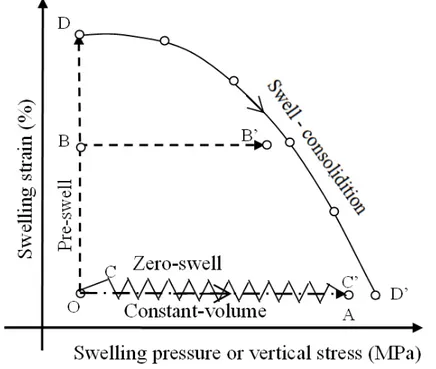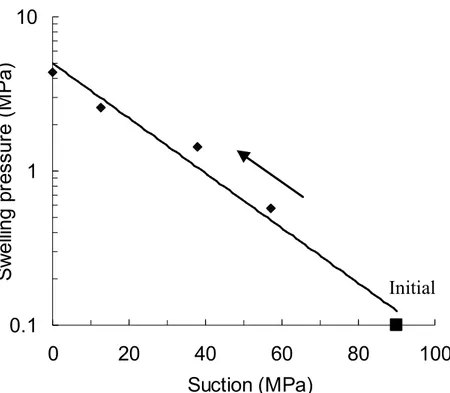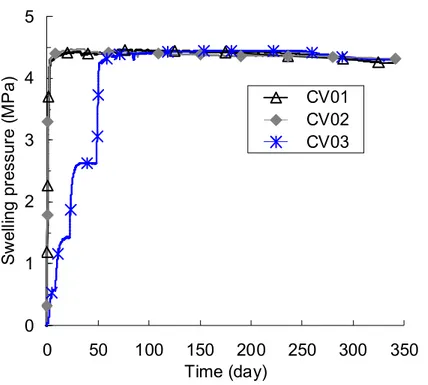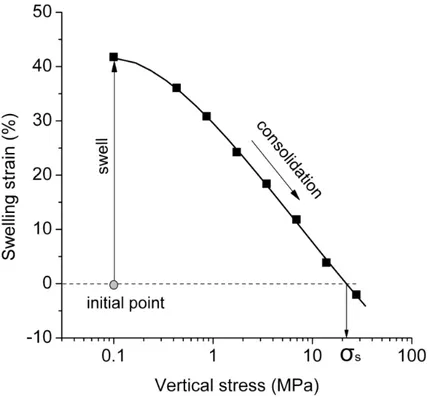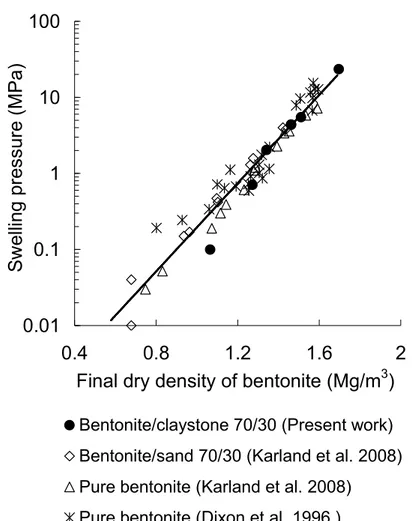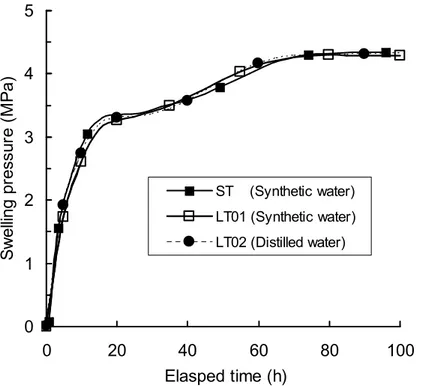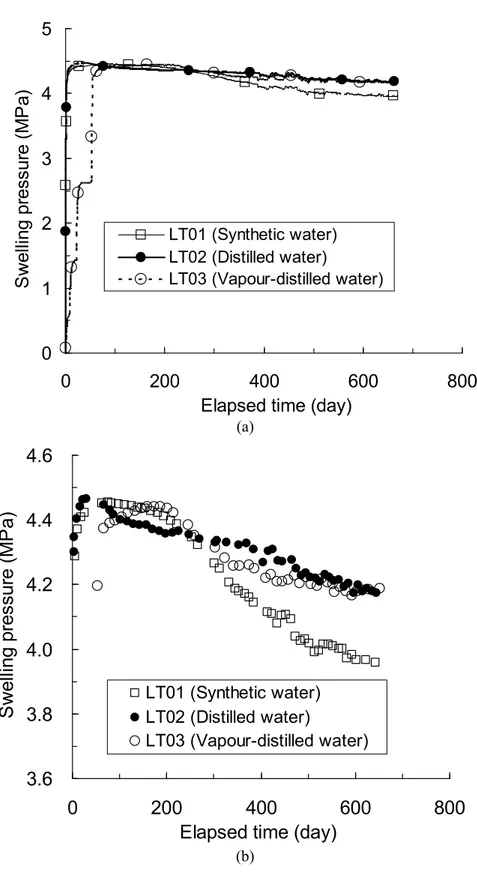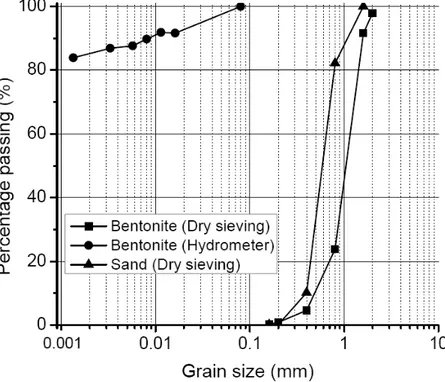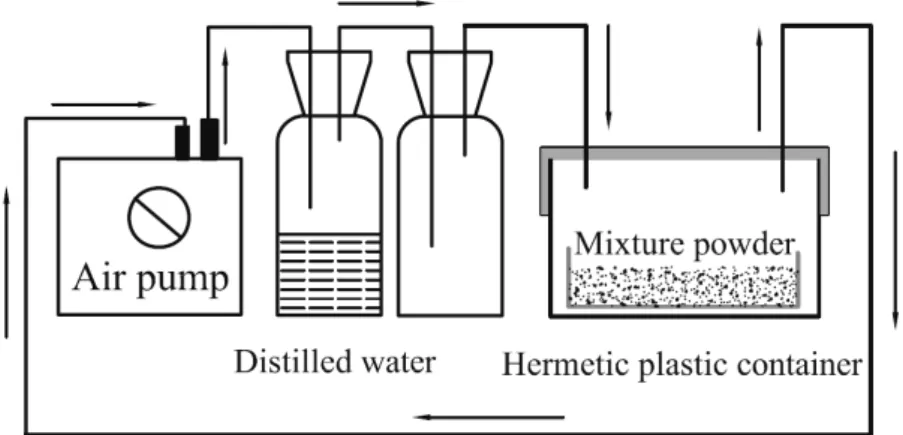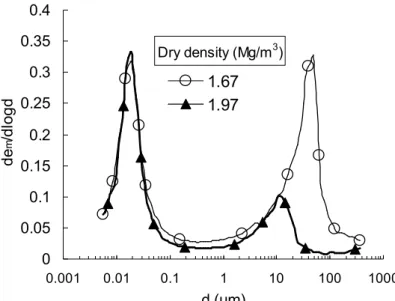HAL Id: pastel-00806392
https://pastel.archives-ouvertes.fr/pastel-00806392
Submitted on 30 Mar 2013HAL is a multi-disciplinary open access archive for the deposit and dissemination of sci-entific research documents, whether they are pub-lished or not. The documents may come from teaching and research institutions in France or abroad, or from public or private research centers.
L’archive ouverte pluridisciplinaire HAL, est destinée au dépôt et à la diffusion de documents scientifiques de niveau recherche, publiés ou non, émanant des établissements d’enseignement et de recherche français ou étrangers, des laboratoires publics ou privés.
materials used for high-level radioactive waste disposal
Qiong Wang
To cite this version:
Qiong Wang. Hydro-mechanical behaviour of bentonite-based materials used for high-level radioactive waste disposal. Other. Université Paris-Est, 2012. English. �NNT : 2012PEST1170�. �pastel-00806392�
THESE
Pour obtenir le grade de
Docteur de l’Université Paris-Est
Discipline : Géotechnique
Présentée par
Qiong WANG
Hydro-mechanical behaviour of bentonite-based materials used
for high-level radioactive waste disposal
Soutenue le lundi 10 Decembre 2012 devant le jury composé de :
Prof. Tom SCHANZ Rapporteur Ruhr-Unicersität Bochum Prof. Cristina JOMMI Rapporteur Politecnico di Milano Prof. Wei-Min YE Examinateur Tongji University
Dr. Xiang-Ling LI Examinateur Euridice Group, SCK/CEN
Dr. Gilles ARMAND Examinateur Agence Nationale pour la Gestion des Déchets Radioactifs Dr.Jean-Dominique BARNICHON Examinateur Institut de Radioprotection et de Sûreté Nucléaire Dr. Anh Minh TANG Examinateur Ecole des Ponts ParisTech
La présente étude concerne le comportement hydromécanique des matériaux compactés à base de bentonite pour le stockage des déchets radioactifs en grande profondeur. Trois matériaux candidats ont été étudiés : la bentonite pure (MX80), le mélange bentonite/argilite broyée et le mélange bentonite/sable. Une étude expérimentale sur la pression de gonflement du mélange bentonite/argilite a été premièrement réalisée. Cette étude a mis en évidence l’effet de la salinité de l'eau, de la procédure et la durée d'hydratation, du vide technologique et des méthodes expérimentales. Une bonne relation entre la pression de gonflement et la densité sèche finale de la bentonite a été élaborée. Ensuite, des essais de rétention d'eau, des essais d'hydratation et des essais oedométriques à succion contrôlée ont été réalisés sur des échantillons à différentes porosités tout en considérant la présence du vide technologique. En introduisant les paramètres comme indice des vides de la bentonite et le ratio volume d'eau, une analyse globale des effets des vides sur la réponse hydromécanique de la barrière ouvragée a été effectuée. Pour avoir un meilleur aperçu de l'évolution de l'étanchéité dans le cas de vide technologique, l’effet de la densité sèche finale (densité après fermeture de vide technologique) et du temps d'hydratation sur la microstructure a été, de même, étudié. La perméabilité de ce matériau à l’état non saturé a été ensuite étudiée en réalisant des essais de rétention d'eau et d'infiltration ainsi que par des observations de la microstructure. Les résultats obtenus ont permis de relier la variation de la perméabilité à l’état non saturé aux changements de la microstructure. Une expérimentation en modèle réduit reproduisant à une échelle 1/10ème les essais in-situ (SEALEX) a été effectuée ; ceci pour étudier la reprise des vides à long terme d’un mélange compacté bentonite/sable, tout en considérant la présence du vide technologique. Les résultats ont été utilisés pour interpréter les observations de l’essai in situ. A une échelle de temps réduite, cette étude fournit des informations utiles pour estimer la durée et l'efficacité de la conception en place. Finalement, les données expérimentales obtenues au laboratoire sur le mélange bentonite/sable ont été interprétées dans le cadre du modèle de Barcelone (BExM). Après comparaison des résultats expérimentaux avec le modèle, les performances et les limitations du modèle ont été analysées.
Mots clés:
comportement hydromécanique, bentonite MX80, microstructure, vide technologique, comportement à long terme, modélisation.This study deals with the hydro-mechanical behaviour of compacted bentonite-based materials used as sealing materials in high-level radioactive waste repositories. The pure MX80 bentonite, mixtures of MX80/crushed claystone and MX80/sand were used in the investigation. An experimental study on the swelling pressure of the bentonite-based materials was first performed. The results evidenced the effects of water chemistry, hydration procedure and duration, technological void and experimental methods. Emphasis was put on the relationship between the swelling pressure and the final dry density of bentonite. Afterwards, the water retention test, hydration test and suction controlled oedometer test were conducted on samples with different voids including the technological void and the void inside the soil. By introducing the parameters as bentonite void ratio and water volume ratio, an overall analysis of the effects of voids on the hydro-mechanical response of the compacted material was performed. To get a better insight into the seal evolution in case of technological void, the effects of final dry density and hydration time on the microstructure features were also characterized. Then, the hydraulic properties under unsaturated state were investigated by carrying out water retention test and infiltration test as well as the microstructure observation. The results obtained allowed relating the variation of hydraulic conductivity to the microstructure changes. A small scale (1/10) mock up test of the SEALEX in situ experiment was also performed to study the recovery capacity of bentonite-based material with consideration of technological void. The results were used for interpreting the in-situ observations. With a reduced time scale, it provides useful information for estimating the saturation duration and sealing effectiveness of the field design. Finally, the experimental data obtained in the laboratory on bentonite/sand mixture were interpreted in the framework of the Barcelona Expansive Model (BExM). By comparing the model with the experimental results, the performance and limitation of the model were analyzed.
The work presented in this thesis would not have been possible without the help of many people who were always there when I needed them the most. I take this opportunity to acknowledge them and extend my sincere gratitude.
First of all, I would like to express my deep and sincere gratitude to my supervisor, Prof. Yu-jun Cui, for his consistent patience and encouragement throughout my period of candidature. I thank him for the systematic guidance and great effort he put into training me in the scientific field. His immense knowledge and his logical way of thinking have been of great value for me.
I would also wish to express my gratitude to Dr. Anh Minh Tang for extended discussions and valuable suggestions which have contributed greatly to the thesis. He is my primary resource for getting my science questions answered and was instrumental in helping me writing this thesis. The thesis has also benefited from comments and suggestions made by Prof. Pierre Delage, Dr. Jean-Dominique Barnichon and Dr. Xiang-Ling Li. Helps from them are gratefully acknowledged. I also record my appreciation to Prof. Weimin Ye for the constant encouragement.
The experimental work would not have been possible without the constant assistance of the technical team of CERMES. I especially thank Emmanuel De Laure for his uncountable helps. I also thank Xavier Boulay, Hocine Delmi, Baptiste Chabot, Clapies Thomas, who helped me a lot during the experimental work. My gratitude goes also to everybody in CERMES for their encouragement, support and all the nice times I had with them.
I am also grateful to IRSN, ANDRA and SCK/CEN for their support. The support from the PHC Cai Yuanpei project and that of the China Scholarship Council (CSC) are also greatly acknowledged.
towards my degree. The completion of this thesis will mean a lot to them, particularly “seeing more of me”. So I dedicate this dissertation to my loving parents and my husband. Without whose love, affection and encouragement this work would not have been possible.
Finally, I am thankful to all my friends who have helped me directly or indirectly in the successful completion of my thesis.
Journal papers
1 Wang, Q., Tang, A.M., Cui, Y.J., Delage, P., Gatmiri, B. 2012. Experimental study on the swelling behaviour of bentonite/claystone mixture. Engineering Geology, Vol. 124, 59–66
2 Wang, Q., Tang, A.M., Cui, Y.J., Delage, P., Barnichon, J.D., Ye, W.M., 2012. The effects of technological voids on the hydro-mechanical behaviour of compacted bentonite-sand mixture. Soils and Foundations, Vol.53, No.2
3 Wang, Q., Tang, A.M., Cui, Y.J., Delage, P., Gatmiri, B. 2012. Long-term effect of water chemistry on the swelling pressure of a bentonite-based material. Submitted to Applied Clay Science
4 Wang, Q., Tang, A.M., Cui, Y.J., Li, X.L., Ye, W.M., 2012. Time and density dependent microstructure features of compacted bentonite. Submitted to Canadian Geotechnical Journal 5 Wang, Q., Tang, A.M., Cui, Y.J., Barnichon, J.D., Ye, W.M., 2012. Hydraulic conductivity and
microstructure changes of compacted bentonite/sand mixture during hydration. Submitted to Engineering Geology
6 Wang, Q., Cui, Y.J., Tang, A.M., Ye, W.M., 2012. Effect of sample preparation on the swelling pressure of compacted bentonite/claystone mixture. Submitted to Korean Society of Civil Engineers 7 Wang, Q., Tang, A.M., Cui, Y.J., Barnichon, J.D., Ye, W.M., 2012. A comparative study on the
hydro-mechanical behaviour of compacted bentonite/sand plug based on laboratory and field infiltration tests. Submitted to Engineering Geology
8 Wang, Q., Tang, A.M., Cui, Y.J., Barnichon, J.D., Ye, W.M., 2012. Investigation of the HM behaviour of compacted bentonite/sand mixture based on the BExM model. Submitted to Computers and Geotechnics
9 Ye, W.M., Chen, Y.G., Chen, B., Wang, Q., Wang. J. 2010. Advances on the knowledge of the buffer/backfill properties of heavily-compacted GMZ bentonite. Engineering Geology. Volume 116, Issues 1-2, Pages 12-20
Conference papers
1. Wang, Q., Tang, A.M., Cui, Y.J., Li X.L., Ye, W.M., 2012. Microstructure Features of Compacted MX80 bentonite Used for Hydraulic Seal in PRACLAY Heater Test, Clays in Natural & Engineered Barriers for Radioactive Waste Confinement, 5th international meeting, Oct. 22-25 2012, Montpellier, France
2. Wang, Q., Tang, C.S., Tang, A.M., Cui, Y.J. 2012. Effect of suction changes on the microstructure of compacted crushed argillites under constant–volume conditions, E-UNSAT2012, June 20-22, Naples, Italy.
3. Ye, W.M., Wang, Q., Pan, H., Chen, B., 2009, Experimental study on the thermal conductivity of compacted GMZ01 bentonite and mixtures, UNSAT-WASTE 2009, Shanghai, China, Aug 24-28,
compacted gaomiaozi bentonite. Proc. of Int. Symp. on Geo-environmental Eng., ISGE2009, September 8-10, 2009, Hangzhou, China. Springer-Verlag GmbH. P: 370-379.
Résumé ... I Abstract ... III Acknowledgements ... V Publications... I
INTRODUCTION... 1
Chapter 1. Experimental study on the swelling property ... 5
INTRODUCTION... 5
Experimental study on the swelling behaviour of bentonite/claystone mixture... 6
1 Introduction ... 6
2 Materials and methods ... 8
3 Experimental results... 12
4 Discussion ... 21
5 Conclusion... 23
References... 24
Chapter 2. Long-term effect of water chemistry on the swelling pressure ... 29
INTRODUCTION... 29
Long-term effect of water chemistry on the swelling pressure of a bentonite-based material ... 30
1 Introduction ... 30
2 Materials and methods ... 31
3 Experimental results... 35
4 Interpretation and discussion... 39
5 Conclusion... 42
References... 43
Chapter 3. Effect of technological void on the hydro-mechanical behaviour... 47
INTRODUCTION... 47
The effects of technological voids on the hydro-mechanical behaviour of compacted bentonite-sand mixture ... 48
1 Introduction ... 48
2 Materials and methods ... 50
3 Experimental results... 58
4 Interpretation and discussion... 65
5 Conclusion... 73
References... 75
Time and density dependent microstructure features of compacted bentonite... 78
1 Introduction ... 78
References:... 96
Chapter 4. Hydraulic conductivity and microstructure changes during hydration... 99
INTRODUCTION... 99
Hydraulic conductivity and microstructure changes of compacted bentonite/sand mixture during hydration ... 100
1 Introduction ... 100
2 Materials and methods ... 102
3 Experimental results... 106
4 Interpretation and discussion... 117
5 Conclusion... 120
References... 120
Chapter 5. Comparative study on the hydro-mechanical behaviour based on laboratory and field infiltration tests ... 123
INTRODUCTION... 123
A comparative study on the hydro-mechanical behaviour of compacted bentonite/sand plug based on laboratory and field infiltration tests ... 124
1 Introduction ... 124
2 Materials and methods ... 126
3 Experimental results... 131
4 Comparison and discussion ... 138
5 Conclusion... 141
References... 142
Chapter 6. Investigation of the HM behaviour of compacted bentonite/sand mixture based on the BExM model ... 145
INTRODUCTION... 145
Investigation of the HM behaviour of compacted bentonite/sand mixture based on the BExM model146 1 Introduction ... 146
2 Barcelona Expansive Model... 147
3 Parameters determination ... 150
4 Simulation and interpretation ... 157
5 Conclusion... 160
References... 161
CONCLUSION ... 165
INTRODUCTION
Deep geological repository has been considered for high-level radioactive waste (HLW) in several countries such as Belgium, China, France, Germany, Japan, Sweden, etc. The safety of this disposal concept is based on the multi-barrier system consisting of the natural barrier (host rock) and engineered barriers (waste container, buffer and sealing elements).
In most cases, bentonite-based materials are chosen as buffer/sealing materials in this system thanks to their low permeability, high swelling and high radionuclide retardation capacities (Pusch, 1979; Yong et al., 1986; Villar et al., 2008). Obviously, these materials, once installed in the repository, will undergo complexe thermo-hydro-mechanical loadings. It is therefore essential to well understand their behaviour under such loadings in assessment of the overall repository safety.
In this context, number of laboratory studies has been conducted to study the performance of buffer/sealing materials (e.g. Delage et al., 1998; Lloret et al., 2003; Romero et al., 2005; Lloret &Villar, 2007). Various experiments were also performed in the under ground research laboratories (URL) such as TSX at the Manitoba, Canada; FEBEX at Grimsel, Switzerland; RESEAL at Mol, Belgium; KEY at Bure, France, etc.
Recently, The Belgian Agency for Management of Radioactive Waste and Enriched Fissile Materials (ONDRAF/EURIDICE) has launched the PRACLAY in-situ heater experiment in the underground laboratory of Mol, Belgium. The pre-compacted MX80 bentonite is used for the hydraulic seal. This hydraulic seal is of annular shape and made up of compacted bentonite bricks. It is installed between the heated zone and the access gallery to achieve the desired undrained hydraulic boundary condition (Tang et al. 2008, Li et al. 2010). The bentonite bricks are expected to swell upon hydration, filling the initial technological voids and compensating the deformation of the host Boom clay. From a practical point of view, it is important to well understand the swelling behaviour of the compacted bentonite.
In France, ANDRA (Angence Nationale pour la Gestion des Déchets RadioActifs) planned to use the mixture of bentonite and crushed Callovo-Oxfordian(COx) claystone excavated from the Bure site of the URL (-490 m, North-eastern France) as possible sealing and backfill
material. This choice has the advantages of being economical by using local excavated argillite and of ensuring better mineralogical and chemical compatibility between the host rock, mixture and pore-water (Andra, 2005; Tang et al., 2011a; Tang et al., 2011b). Nevetheless, the question of possible interaction between bentonite and claystone remains, at both short and long terms.
In order to identify the key factors related to the long-term performance of bentonite-based sealing systems with consideration of initial technological void, the French institution IRSN (Institut de Radioprotection et de la Sûreté Nucléaire) has launched the SEALEX project. This project consists of a series of in situ experiments performed in natural conditions in Tournemire Underground Research Laboratory. The experimental program was purposefully built allowing systematically exploring the effect of technical specifications, design, construction, defection, etc. (Barnichon et al. 2009, 2010). Clay seals made of pre-compacted disks of MX80 bentonite/sand mixture were considered. The seals will undergo first the saturation stage. During this process, the injected water volume, total pressure and relative humidity changes are monitored at several positions. Afterwards, hydraulic tests will be performed to determine the overall hydraulic properties (inherent permeability, occurrence of leakage) of the sealing system. The impact of the technical specification and design of the sealing plug will be also investigated by changing the intra-core geometry (jointed vs. monolithic disks), core composition (MX80/sand ratio) and core conditions (pre-compacted vs. in situ compacted). Furthermore, the effect of altered conditions will be also studied by simulating an incidental decrease of swelling pressure caused by a failure of the concrete confining structure. Considering the complexity of the in-situ conditions, it appears important to identify the hydro-mechanical behaviour of compacted mixture in the laboratory condition in order to obtain useful information for interpreting the results obtained in the field condition.
The present work is related to the three projects mentioned above with three materials studied: (1) the pure MX80 bentonite used for the hydraulic seal in the PRACLAY in-situ experiment at Mol (Belgium), (2) the MX80/crushed claystone mixture planned to be used in the underground research laboratory (URL) at Bure site (France), (3) MX80/sand mixture used in the SEALEX in situ experiments performed at Tournemire site (France). Emphasis was put on the effect of technological voids. Both laboratory testing and constitutive modeling were conducted.
The results are subjected to several published and submitted papers. A first paper on the swelling behaviour of bentonite/claystone mixture has been published in the journal Engineering Geological; the second paper on the effects of technological voids on the hydro-mechanical behaviour of compacted bentonite/sand mixture has been accepted by the journal Soils and Foundations; and five others were submitted to Applied Clay Sscience, Canadian Geotechnical Journal, Engineering Geology, Computers and Geotechnics, respectively. The dissertation is presented in the form of papers/manuscripts, each chapter composing an introduction and the corresponding papers/manuscripts.
The first chapter focuses on the swelling pressure of the bentonite/claystone mixture (Bure URL, ANDRA), which corresponds to the paper published in Engineering Geology. The effects of water chemistry, the hydration procedure, the pre-existing technological voids and the experimental methods on the swelling pressure were investigated. Based on the experimental results, the relationship between the swelling pressure and the final dry density of bentonite was proposed.
The second chapter analyses the long-term effect of pore water chemistry on the swelling pressure of bentonite/calystone mixture (Bure URL, ANDRA). Emphasis was put on the physico-chemical interaction between the minerals of claystone, minerals of bentonite and different fluids involved. The kinetics of swelling pressure was also described by comparing a one-step soaking test with multistep soaking test.
The third chapter corresponds to the results presented in two papers. The first, being accepted by Soils and Foundation, presents the results of water retention test, hydration test, suction controlled oedometer test and hydraulic test on samples with different voids including the technological void and the void inside the soil (SEALEX prject, IRSN). By introducing the parameters as bentonite void ratio and water volume ratio, the effects of technological voids on hydro-mechanical behaviour were analyzed. The second section characterises the effects of final dry density and hydration time on the microstructure features of the compacted bentonite in case of technological void, which was directly related to the macroscopic hydro-mechanical behaviour (PRACLAY, ONDRAF/EURIDICE).
The forth chapter presents the water retention test and infiltration test as well as the microstructure observation on the bentonite/sand mixture (SEALEX prject, IRSN). Based on the experimental results, the variations of hydraulic conductivity with suction was determined
A comparative study on the hydro-mechanical behaviour of compacted bentonite/sand plug based on laboratory and field infiltration tests is presented in the fifth chapter (SEALEX prject, IRSN). By comparing the first results from the in situ test, the phenomena identified in the laboratory were used for interpreting and estimating the performance of the bentonite-based plug in the field.
In the sixth and last chapter, the hydro-mechanical behaviour of the MX80 bentonite/sand mixture is interpreted in the framework of the Barcelona Expansive Model (BExM). After determinating the parameters based on the experimental results, the hydro-mechanical (H-M) responses of the material identified from other tests with different stress paths were simulated, allowing analysing the performance and limitation of the model (SEALEX prject, IRSN).
Chapter 1. Experimental study on the swelling property
INTRODUCTION
The main function of buffer/sealing material is to fill up all the existing voids, creating a relatively impermeable zone around the high-level radioactive waste. This role termed as “self-sealing” (Komine, 2004; Komine and Ogata, 2003) is essential to ensure the overall safety of the geological disposal. Thus, the swelling properties constitute a key factor in the design and development of the sealing/backfill materials and need to be studied in depth. Previous studies showed that the swelling properties depend strongly on the initial dry density and water content of the soil specimen (Komine et al., 1994; Villar et al., 2008). The swelling properties can be affected by the chemical composition of the saturating fluid: the swelling capacity of the bentonite decreases with the increase in salinity of saturating fluid, although this influence becomes less significant for higher densities (Pusch, 1980; Sugita et al., 2003; Karnland et al., 2005; Castellanos et al., 2008; Siddiqua et al., 2011). Moreover, the swelling potential may decrease with time due to the rearrangement of clay particles with time (Nalzeny et al., 1967; Day et al., 1994; Subba Rao et al., 2003; Delage et al., 2006).
Accounting for these factors, this chapter presents an experimental study on the swelling pressure of the mixture MX80 bentonite/crushed Cox claystone. A series of experiments including determination of the swelling pressure of compacted samples by constant-volume method, pre-swell method, zero-swell method and swell–consolidation method were performed. The influences of water chemistry, hydration procedure and duration, pre-existing technological void and loading-wetting paths on the swelling pressure of compacted samples were analyzed.
This work was published in « Engineering Geology», the article is represented here in its original version.
Wang, Q., Tang, A. M., Cui, Y.J., Delage, P., Gatmiri, B. 2012. Engineering Geology, Vol. 124, 59–66.
Experimental study on the swelling behaviour of bentonite/claystone
mixture
Qiong Wang1, Anh Minh Tang1, Yu-Jun Cui1, Pierre Delage1, Behrouz Gatmiri2
Abstract: A mixture of the MX80 bentonite and the Callovo-Oxfordian (COx) claystone were investigated by carrying out a series of experiments including determination of the swelling pressure of compacted samples by constant-volume method, pre-swell method, zero-swell method and swell–consolidation method. Distilled water, synthetic water and humidity controlled vapour were employed for hydration. Results show that upon wetting the swelling pressure increases with decreasing suction; however, there are no obvious effects of synthetic water chemistry and hydration procedure on the swelling behaviour in both short and long terms. For the same initial dry density, the swelling pressure decreases with increasing pre-swell strain; whereas there is a well defined logarithmic relation between the swelling pressure and final dry density of the sample regardless of the initial dry densities and the experimental methods. It was also found that swelling pressure depends on the loading-wetting conditions as a consequence of the different microstructure changes occurred in different conditions. Furthermore, it was attempted to elaborate a general relationship between the swelling pressure and the final dry density for various reference bentonites. Keywords: bentonite/claystone mixture; swelling pressure; water chemistry effect; long term behaviour; final density; correlation.
1 Introduction
Deep geological repository is being considered for high-level radioactive waste (HLW) in several countries such as China, Belgium, France, Germany, Japan, Sweden, etc. In most cases, compacted bentonite-based materials are chosen as sealing/buffer materials thanks to their low permeability, high swelling and high radionuclide retardation capacities (Pusch, 1979; Yong et al., 1986; Villar et al., 2008).
Once the repository is closed and local groundwater conditions are re-established, the water in the host rock formation will move to the repository. The bentonite-based material absorbs water and swells, filling the technical voids as the gaps between the bentonite bricks themselves, between the canister and the bricks, between bricks and the host rock, as well as the fractures in the host rock due to excavation. After that, the subsequent swelling is restrained by the host rock and swelling pressure develops. From a mechanical point of view,
1.Ecole des Ponts ParisTech, UR Navier/CERMES 2. ANDRA, France
in order to ensure the stability of the system, the swelling pressure must be lower than the in situ minor stress: 7 MPa in the Underground Research Laboratory (URL) of Bure site, France (Delege et al., 2010; Tang et al., 2011a); 3-4 MPa at Tournemire site, France (Barnichon et al., 2009) and 4-5 MPa at Mol site, Belgium (Li et al., 2009), etc. As the compacted bentonite-based material is a key component of a repository system, it governs the overall behaviour of the whole system. Hence, a proper understanding of how the compacted bentonite-based material behaves during hydration process is essential for the assessment of the short and long term performance of the repository system.
The behavior of compacted bentonite-based material upon wetting has been widely investigated, in terms of swelling properties (Pusch, 1982; Komine and Ogata, 1994, 2003, 2004a; Delage et al., 1998; Agus and Schanz, 2005; Komine et al., 2009); hydraulic behaviour under saturated state (Kenney et al., 1992; Dixon et al., 1999; Komine, 2004b;) and unsaturated state (Borgesson et al., 1985, 2001; Kröhn, 2003; Lemaire el al., 2004; Loiseau et al., 2002; Cui et al., 2008). There are also many studies on the effect of temperature (Komine and Ogata, 1998; Romero et al., 2001; Villar and Lloret, 2004; Tang et al., 2005; Tang et al., 2007; Tang et al., 2008a; Tang and Cui, 2009) and water chemistry of the saturating fluid (Pusch 2001a, Karland et al., 2005; Suzuki et al., 2005; Komine et al., 2009) on the hydro-mechanical (HM) behaviour.
For the swelling properties, it has been found that the swelling pressure determined in the laboratory can be affected by the experimental methods (Sridharan et al., 1986; Tang el al., 2011b). Normally, different methods give different values of swelling pressure due to the difference in the loading and wetting conditions in each method (Abdullah et al., 1998, 1999). In addition, the swelling properties depend on the initial dry density and water content of the soil specimen. The higher the initial dry density, the higher the swelling pressure or the higher the swelling strain; the swelling strain decreases with increasing initial water content, but the swelling pressure seems not to be affected by the initial water content (Komine et al., 1994; Villar et al., 2008). The swelling properties can be also affected by the chemical composition of the saturating fluid: the swelling capacity of the bentonite decreases with the increase in salinity of saturating fluid, although this influence becomes less significant for higher densities (Pusch, 1980; Sugita et al., 2003; Karnland et al., 2005; Castellanos et al., 2008; Siddiqua et al., 2011). Moreover, Studies on the aging effects on the swelling behavior show that the swelling potential may decrease with time due to the rearrangement of clay particles
Very often, bentonite/sand mixtures are considered for the reasons of good control of swelling pressure, large thermal conductivity and a better mechanical resistance. In France, the mixture of bentonite and crushed Callovo-Oxfordian (COx) claystone excavated from the Bure site of the ANDRA URL (-490 m, North-eastern France) was proposed as a possible sealing and backfill material. This choice has several advantages: (i) it is more economical by using local excavated claystone; (ii) the negative impacts on the environment is reduced by recycling the excavated material; (iii) there is better compatibility of mineralogical and chemical compositions with host rock, allowing reduction of complex physico-chemical interaction with the host rock (Andra, 2005; Tang et al., 2011a; Tang et al., 2011b). On the other hand, unlike relatively inert sand, claystone contains clay minerals and interaction between argilite and bentonite may occur, affecting the hydro-mechanical behaviour of the compacted mixture. Moreover, this interaction can be of long term. Particular attention should be paid to this aspect.
This study focuses on the swelling properties of the mixture MX80 bentonite/crushed Cox claystone. A series of swelling tests were performed under constant temperature (20±1°C). The influences of water chemistry, hydration procedure and duration, pre-existing technical void and loading-wetting paths on the swelling pressure of compacted samples were investigated. Emphasis was put on the relationship between the swelling pressure and the dry density of bentonite.
2 Materials and methods
2.1 Materials
The commercial MX80 bentonite from Wyoming, USA, was used. Table 1 lists its physical parameters. It appears that the proportion of montmorillonite is dominant in the bentonite (92 %); it has an average specific gravity of 2.76, a liquid limit of 520%, and a plastic limit of 42%. The grain size distribution determined by sedimentation in Figure 1 shows that 84% grains are smaller than 2 µm (clay fraction).
Table 1 Characteristics of MX80 bentonite (Tang et al., 2008b)
Montmorillonite (%) Quartz (%) wl (%) wp(%) Ip ρs (Mg/m3)
Callovo-Oxfordian (COx) claystone taken from the Bure site of the ANDRA URL was studied. It contains 40–45% clay minerals (mainly interstratified minerals illite–smectite), 20–30% carbonates and 20–30% quartz and feldspar (Hoteit et al., 2000; Lebon and Ghoreychi, 2000; Zhang et al., 2004). The specific gravity is 2.70. The excavated claystone was air-dried (w = 2.64%) and crushed to powder. The grain size distribution determined by sedimentation is presented in Figure 1. It confirms that 40% grains are clays (< 2 µm).
Figure 1. Grain size distribution of MX80 bentonite and crushed COx claystone
Both distilled water and synthetic water having the same chemical composition as the site water (see Table 2) were used.
Table 2 Chemical components of the synthetic water
Components NaHCO3 Na2SO4 NaCl KCl CaCl2.2H2O MgCl2.6H2O SrCl2.6H2O
Mass (g)
per 1L solution 0.28 2.216 0.615 0.075 1.082 1.356 0.053
2.2 Samples preparation
All the tests in this study were performed on samples of compacted bentonite/claystone mixture with a bentonite content of 70 % in dry mass. Bentonite and claystone powders with the initial water contents of 11.8 % and 2.64 % respectively, were used for the samples preparation. Their grain size distributions were determined by sieving and are presented in
Samples were statically compacted in an oedometer cell (38 or 70 mm in internal diameter) at a controlled rate of 0.05 mm/min. A load transducer was used for axial force monitoring, and a micrometer dial gauge was used for axial displacement monitoring. After compaction, the specimen was carefully transferred into the hydration cell (with the same diameter as the oedometer cell) by connecting the bottom of the two cells together. This procedure allows the lateral stress released without significant increase in sample diameter.
2.3 Experimental methods
Various methods were used to determine the swelling pressure upon wetting. The stress paths of these methods are presented in Figure 2.
Figure 2. Stress path of various experimental methods used to determine the swelling pressure
For the “constant-volume” method (stress path OA), the devices presented in Figure 3 and Figure 4 were used. The constant-volume cell includes three parts (Figure 3, Tang et al., 2011b): (1) the bottom part containing a porous stone and a drainage system; (2) the middle cell (70 mm inner diameter) used to prevent radial swelling, with two air outlets; (3) the top part incorporating a total pressure sensor to monitor the swelling pressure. Figure 4 presents the setup used to control the suction in the soil sample using the vapour equilibrium technique (see Delage et al., 1998 for more details). When flooding the soil sample, this system was removed and the water inlet was connected to a water reservoir.
Figure 3. Constant-volume cell
Figure 4. Schematic view of constant volume cell with suction control system
For the “pre-swell” method (stress path OBB′), the sample was first allowed to swell freely in the axial direction to a certain value (Point B, noted as “pre-swell”), then the piston was fixed permitting the generation of swelling pressure that was monitored by the load transducer. This method was used to investigate the effect of pre-existing technical voids (simulated by the pre-swell allowed in the tests) on the swelling pressure.
For the “zero-swell” and “swell-consolidation” methods, the equipment employed was a conventional oedometer (Basma et al., 1995; Nagaraj et al., 2009). Firstly, a low initial load of 0.1 MPa was exerted on the specimen prior to water flooding. As the specimen wetted up it attempted to swell. When the swell exceeded 10 µm (equivalent to 0.1%), additional pressure was added in small increment to bring the volume of soil specimen back to its initial value
repeated until the specimen ceased to swell (OCC′ in Figure 2). The swelling pressure was defined as the stress where no more swelling strain was observed.
The “swell-consolidation” method consists of re-saturating the soil under a low vertical pressure of 0.1 MPa until full swell was achieved. After swell completion, standard consolidation test was conducted. The pressure required to compress the specimen back to its original void ratio is defined as the swelling pressure (Basma et al., 1995; Abdullah et al., 1998, 1999; Agus, 2005). The corresponding stress path ODD′ is shown in Figure 2. In this path, point D also represents the maximum swelling strain of the sample.
The experimental programme is shown in Table 3. Three tests were performed using the constant-volume method to study the effect of water chemistry and the hydration procedure (CV01, CV02 and CV03). Distilled water and synthetic water was used in test CV01 and CV02, respectively. In test CV03, three suctions (57 MPa, 38 MPa and 12.6 MPa) were first applied step by step using vapor equilibrium technique (as shown in Figure 4), prior to distilled water flooding in the last stage.
Four tests were performed by pre-swell method to study the influence of pre-existing technical voids on the swelling pressure (PS01 – PS04). Different pre-swells were allowed before measurement of the swelling pressure. Note that for test PS04 the sample was allowed to swell freely to reach the maximum pre-swell strain.
Two other tests were conducted using zero-swell method (ZSO1) and swell-consolidation method (SCO1), respectively, for analyzing the influence of loading-wetting paths followed in different experimental methods.
As it can be seen in Table 3, the tests conducted have in general long duration, from 80 h to one year.
3 Experimental results
Figure 5 presents the results from tests CV01 and CV02 with distilled water and synthetic water respectively, during the first 100 h. The two curves are very similar, showing negligible effect of water chemistry (in the range considered). With water infiltration, swelling pressure increased first very quickly; after about 20 h the swelling pressure reached a first stability stage. At 32h, the swelling pressure restarted to increase and it reached a second stability stage at 100 h. The final values are 4.30 MPa and 4.37 MPa for CV01 and CV02, respectively.
Table 3 Test programme
Test No. Injected water Method Initial dry density
(Mg/m3) Duration
CV01 Distilled Constant-volume 1.70 1 year
CV02 Synthetic Constant-volume 1.70 1 year
CV03 Vapour and distilled Constant-volume 1.70 1 year
PS01 Synthetic Pre-swell ε = 10% 1.90 100 h
PS02 Synthetic Pre-swell ε = 20% 1.90 100 h
PS03 Synthetic Pre-swell ε = 25% 1.90 100 h
PS04 Synthetic Pre- swell ε = max 1.90 80 h
ZSO1 Synthetic Zero-swell 1.70 80 h
SCO1 Synthetic Swell-consolidation 1.90 4 months
0
1
2
3
4
5
0
20
40
60
80
100
Time (hour)
S
w
e
lli
n
g
p
re
s
s
u
re
(
M
P
a
)
CV01
CV02
Figure 5. Evolution of swelling pressure for test CV01 and CV02 during the first 100 h.
The results of test CV03 is presented in Figure 6. The initial suction of sample was about 90 MPa (measured by a relative humidity sensor on the soil specimen after the compaction and prior to the installation in the cell). The application of the first suction of 57 MPa resulted in a swelling pressure of 0.57 MPa. Then, the second suction of 38 MPa was applied and the swelling pressure reached 1.43 MPa. With the third suction of 12.6 MPa the swelling pressure increased to 2.61 MPa. The zero suction applied by distilled water led the sample to a maximum value of 4.39 MPa swelling pressure. This value is very close to that from test CV01(4.30 MPa) and CV02(4.37 MPa) in which the samples were flooded directly with water.
Figure 6. Evolution of swelling pressure for test CV03 during decreasing of suction.
Figure 7 presents the relationship between the swelling pressure (σs in MPa) and the suction
(s in MPa), with the values obtained from test CV03. An exponential function can be used to satisfactorily describe this relationship:
s s 0178 . 0 10 9908 . 4 × − = σ (Eq.1)
0.1
1
10
0
20
40
60
80
100
Suction (MPa)
S
w
e
lli
n
g
p
re
s
s
u
re
(
M
P
a
)
Initial
In Figure 8, the whole results from the three tests CV01, CV02 and CV03 during one year are presented. It appears that after a long period of one year, there was just a slight decrease of swelling pressure and the values for the three samples still remain very close (4.23MPa, 4.32MPa and 4.29MPa for test CV01, CV02 and CV03, respectively). This shows a negligible effect of any bentonite-claystone interaction on the swelling pressure.
0 1 2 3 4 5 0 50 100 150 200 250 300 350 Time (day) S w e lli n g p re s s u re ( M P a ) CV01 CV02 CV03
Figure 8. Evolution of swelling pressure for tests CV01, CV02, and CV03 for 1 year
The evolution of swelling pressure for the specimens having the same initial dry density of 1.90 Mg/m3 with different pre-swells is presented in Figure 9. An expected significant decrease of swelling pressure with increasing pre-swell is observed. For the pre-swells of 10, 20 and 25%, the swelling pressures obtained are 5.38, 2.03 and 0.7 MPa, respectively. Note that the maximum swelling strain from test PS04 reaches 43 %.
The results from test SCO1 using the swell-consolidation method are presented in Figure 10. As wetting up, the sample swelled under a low vertical pressure of 0.1 MPa and the maximum swelling strain reached 41.76%. Further compression gave a normal consolidation curve that allows the determination of the swelling pressure: σs = 22.20 MPa.
For test ZSO1 (zero-swell method) on a sample at an initial dry density of 1.70 Mg/m3, a vertical stress of 4.38 MPa was needed to keep the void radio constant. By definition, this value is the swelling pressure by this method.
e = 10 % e = 20 % e = 25 % 0 1 2 3 4 5 6 0 20 40 60 80 100 Time (h) S w e lli n g p re s s u re ( M P a ) PS01 PS02 PS03
Figure 9. Evolution of swelling pressure with various pre-swells
Figure 10. Swelling strain versus vertical stress applied for test SCO1
From the results in Figure 9, the swelling pressure is plotted versus the pre-swell strain in Figure 11. The maximum pre-swell of test PS04 and the swelling strain in SCO1 (swell consolidation method) are also presented in this figure. Note that all specimens had the same initial dry density of 1.90 Mg/m3 and all flooded with synthetic water. It appears that the result of SCO1 is close to that of PS04 (free swell) showing a good repeatability of the
free-swell tests. A linear correlation can be obtained between the swelling strain allowed (ε in %) and the logarithm of swelling pressure (σs in MPa):
946 . 23 ) ( 32 . 19 + − = Lg
σ
sε
(Eq.2)Figure 11. Pre-swell versus swelling pressure
In Figure 12, the swelling pressure determined by the pre-swell method (PS01, PS02, PS03, PS04), constant-volume method (CV02), zero swell method (ZSO1) are plotted in the plane of void ratio/logarithm of vertical stress, together with the consolidation line from test SCO1. Point O and O′ correspond to the initial states of the samples at a dry density of 1.90 Mg/m3 (PS01, PS02, PS03, PS04 and SCO1) and 1.70 Mg/m3 (CV02 and ZSO1), respectively. It can be noted that at the same void ratio, the vertical stress of the consolidation curve (SCO1) is slightly higher than the swelling pressure determined by other methods.
Figure 13 shows the measured swelling pressure versus the final dry density of the bentonite/claystone mixture for all the tests. Note that these tests have been performed with two different initial dry densities (ρdi = 1.90 Mg/m3 for tests PS01, PS02, PS03, PS04, SCO1;
and ρdi = 1.70 Mg/m3 for tests CV02, ZSO1), and using various methods (see Table 3). In
spite of this, a unique correlation seems enough to describe the relationship between the swelling pressure
σ
s (MPa) and the final dry density of the mixture ρdm (Mg/m3):Figure 12. Swelling pressure or vertical pressure versus void ratio of mixture
PS04 SCO1 PS01 ZSO1 CV02 PS02 PS03 0.1 1 10 100 1.3 1.5 1.7 1.9
Final dry density (Mg/m3)
S w e lli n g p re s s u re ( M P a ) `
This shows that the swelling pressure of the compacted claystone/bentonite mixture is mainly dependent on the final dry density of the mixture. For a deeper analysis on the role of the bentonite itself in the swelling pressure development of the bentonite- based mixutre, the dry density of bentonite (ρdb) has been proposed by assuming that the water content of additives
(claystone in this study) kept constant, while the water except this part was absorbed by bentonite. It means that the volume of bentonite (Vb) is the difference between the total
volume (V) and the volume of additive (soil particles and water inside). Therefore the bentonite dry density can be calculated by the following equation:
) 1 )( 100 / 1 ( ) 100 / 1 ( ) 100 / ( a m m sa sa m db w B w G G B + − − + = ρ ρ ρ (Eq.4) where ρm (Mg/m
3) is the mixture density; B (%) is the bentonite content (in dry mass) in the mixture; wm is the water content of the mixture; wa is the initial water content of the additive
(equals zero for sand); Gsais the specific gravity of additive. In this study, wa = 2.64%, B = 70
%, Gsa = 2.70.
Using Eq. 4, the results shown in Figure 13 were re-analysed and Figure 14 shows the variations of swelling pressure with the final dry density of bentonite. In the same figure, the results collected from other works on the MX80/sand mixture (Karland et al., 2008) and the pure MX80 bentonite (Karnland et al., 2008; Dixon et al., 1996) are also presented. A very similar relationship is obtained for the different data sets, showing that the swelling pressure mainly depends on the final dry density of bentonite, sand and claystone being both inactive components in the mixtures for the swelling pressure development.
To further investigate this point, results on other reference bentonites were collected and analysed in the same fashion. Figure 15 shows the variations of swelling pressure with the final dry density of MX80 (from Figure 14), FoCa7 (Imbert et al., 2006), FEBEX (Villar et al., 2002) and Kunigel V1 (Dixon et al., 1996). It appears that for each bentonite, there is a unique relationship between the swelling pressure and the final dry density of bentonite. However, the relationships are not the same. A general expression can be proposed:
db
s
βρ
α
σ = ×exp Eq.6
0.01
0.1
1
10
100
0.4
0.8
1.2
1.6
2
Final dry density of bentonite (Mg/m
3)
S
w
e
lli
n
g
p
re
s
s
u
re
(
M
P
a
)
Bentonite/claystone 70/30 (Present work) Bentonite/sand 70/30 (Karland et al. 2008) Pure bentonite (Karland et al. 2008)
Pure bentonite (Dixon et al. 1996 )
Figure 14. Results of various mixtures using MX80 bentonite - swelling pressure versus final dry density of bentonite 0.01 0.1 1 10 100 0.5 1 1.5 2 2.5
Final dry density of bentonite (Mg/m3)
S w e lli n g p re s s u re ( M P a ) MX80 Foca Febex Kunigel V1
Table 4 shows the values of α and β for the four bentonites analysed. In the table, the mineralogy of these materials is also presented. The difference of parameters can be related to the different types of clay (i.e. montmorillonite, beidellite and saponite, etc), montmorillonite content and type of exchangeable cations (i.e. calcium or sodium). In general, the swelling capacity of sodium bentonite is higher than that of calcium bentonite; with the same type of exchangeable cations, a larger montmorillonite content leads to a higher swelling pressure.
Table 4 Montmorillonite content and external cations type of several bentonites
Bentonite α β Montmorillonite Content (%) Type
MX 80 1.78×10-4 6.75 75-90 Na
FEBEX 9.80×10-5 6.85 92 Ca
FoCa 7.83×10-7 9.24 50 Beidellite, 50 Kaollite Ca
Kunigel V1 3.67×10-3 3.32 48 Na
4 Discussion
It has been observed that the effect of the chemistry of Bure site water on the swelling pressure is negligible. However, it is generally accepted that the swelling pressure decreases with the increase in salinity of the pore-water, although this decrease becomes less significant in case of high density (Karnland et al., 2005; Castellanos et al., 2008; Siddiqua et al., 2011; Komine et al., 2009). Castellanos et al. (2008) reported that the swelling pressure of the FEBEX bentonite compacted to a dry density of 1.65 g/cm3 decreases to almost half its initial value when 2 mol/L CaCl2 and NaCl/L solutions are used as saturating fluids; At low salinities (0.004 mol/L, granitic water), the swelling pressure of bentonite seems not to be affected by the salinity changes at a dry density ranging from 1.40 to 1.70 Mg/m3. It appears that for the studied bentonite/claystone mixture, the high density and the low salinity of synthetic water together resulted in the negligible effect of water chemistry on the swelling pressure. This can be explained by the theory of cations filtration (Komine et al., 2009). For high dry density of bentonite based materials, the distances between the montmorillonite mineral layers being very small, these layers can filter the cations in the solution; on the contrary, in the case of low dry density, the cations in solution can infiltrate easily into the montmorillonite mineral layers due to the larger distances between them, thus affecting the swelling behaviour.
For the sample wetted with suction control (CV03), an exponential function was found between the swelling pressure and the suction applied. This can be explained as follows. As clay samples are exposed to humid water vapour, water molecules first migrate into the open channels and adsorbed on the exposed mineral surface (Pusch, 2001b; Arifin, 2008), then move to elementary clay layers. The number of water molecules absorbed by the clay layers depends on the relative humidity or suction (Pusch, 2001b; Saiyouri et al., 2004; Delage, 2006), and this water molecules number defines the swelling pressure of the sample. Therefore the swelling pressure is suction or relative humidity dependent. After the sample was flooded with distilled water, the maximum swelling pressure was found close to that obtained by water-flooding the sample directly, indicating the negligible effect of wetting procedure. This phenomenon can be explained by the mechanism identified by Cui et al. (2002): when hydrating by decreasing suction (57-38-12.6 MPa) under confined conditions, the size of macro-pores was progressively decreased, whereas the micro-pores remained almost un-affected. The micro-pores started to change only when the water saturation is approached. This suggests that step-wetting by suction control and direct saturation by water flooding may lead to similar final microstructures, thus similar final swelling pressures. Yang et al. (2008) reported that the mineralogical composition of the bentonite will not be stable under the chemistry fluid infiltration and its properties may degrade over long time periods. Moreover, for the bentonite/claystone mixture used in this study, interaction of claystone with water and bentonite was suspected. This justifies the long swelling tests kept over one year. However, no any significant effects were observed on the swelling pressure. It is possible that one year test is not long enough and this point should be studied further with longer tests, giving the long-term nature of the nuclear waste disposal.
A linear correlation was observed between the pre-swelling strain and the logarithm of swelling pressure for the samples with the same initial dry density. This line defines the limit of swelling potential: the samples at the same initial state followed different stress-volume paths until reached this limit and then no further expansion occurred. This is consistent with the conclusion of Villar et al. (2008) and Siemens et al. (2009) who found a similar relation between swelling strain and swelling pressure. It can be seen that the final state of specimen controlled the swelling pressure: for the samples with the same initial state, different pre-swelling strains led to different final dry densities and thus resulted in different swelling pressure. Moreover, a unique relationship was observed between the swelling pressure and the final dry density of the samples whatever the initial dry density, the percentage of pre-swell
and the experimental method. This also enhances the conclusion that the final state of the sample controls the swelling pressure. Further analysis showed that the swelling pressure mainly depends on the final dry density of bentonite in the mixture. This observation is in agreement with the conclusion of Lee et al. (1999) and Agus (2005) who noted that the swelling pressure of bentonite/sand mixtures with different bentonite contents is a function of the final bentonite dry density. This suggests that the swelling mechanism of bentonite-based materials is the same as that of pure bentonites.
At the same void ratio, the swelling pressure determined by different methods was found slightly lower than the vertical stress needed to reach the same void ratio following the swell-reload path (swell-consolidation method). This was in agreement with the results by many other authors (Justo et al., 1984; Sridharan et al., 1986; Basma et al., 1995; Abdullah et al., 1998, 1999; Agus, 2005; Villar, 1999; Villar et al., 2008), and can be considered as a consequence of the coupling between the microstructure and macrostructure (Gens and Alonso, 1992; Villar, 1999; Sánchez et al., 2005). For the swell-consolidation oedometer test, wetting took place under a low vertical load and the void ratio increased greatly due to the large microstructural changes which led to more intense breakage of particle aggregates and hence to a more uniform distribution of the expandable component. In this case a higher vertical stress was needed to compensate the large macrostructure deformation. By contrast, smaller microstructure and macrostructure interaction were involved in other methods, giving rise to lower stress at full saturation. Furthermore, the relative larger displacement in the swell-consolidation oedometer test would mobilise higher friction and this friction can also contribute to the phenomenon observed.
5 Conclusion
The swelling pressure of bentonite/claystone mixture was determined by different methods. The effects of the water chemistry, the hydration procedure, the pre-existing technical voids and the experimental methods on the swelling pressure were investigated. From the experimental results the following conclusion can be drawn.
There was no obvious effect of water chemistry on the swelling pressure due to the high density and the low salinity of synthetic water.
An exponential function was found between the swelling pressure and the suction applied; no effect of hydration procedure on the final swelling pressure was observed.
The swell-consolidation method gives higher swelling pressure mainly because of the coupling between the microstructure deformation and macrostructure deformation. The effect of friction is also to be considered for this phenomenon.
The swelling pressure of bentonite-based materials mainly depends on the final dry density of the bentonite in the mixture, suggesting that the swelling mechanism of bentonite-based materials is the same as that of pure bentonites. A general relationship between the swelling pressure and the final dry density of various bentonites was proposed, with two parameters depending on the montmorillonite content and the type of exchangeable cations.
From a practical point of view, the relationship elaborated between the swelling pressure and the final bentonite dry density is helpful in designing the sealing/filling buffers with bentonite-based materials: when the initial state of bentonite-based materials and the technical voids are known, the final swelling pressure can be predicted. Moreover, the crushed Cox claystone can be used to form the bentonite/claystone mixture because it behaves as sand. However it should be noted that this conclusion is based on the results from one year tests and further studies with longer tests are needed to gain more confidence on this aspect.
Acknowledgements
This work was conducted within the framework of GM2 of the French National Agency for Nuclear Waste Management (ANDRA). The conclusions and the viewpoints presented in the paper are those of the authors and do not necessarily coincide with those of ANDRA. The support from the PHC Cai Yuanpei project (24077QE) and that of the China Scholarship Council (CSC) are also greatly acknowledged.
References
Abdullah, I., Mhaidib, A., 1998. Prediction of swelling potential of an expansive shale. Proceedings Of The Second International Conference On unsaturated soils. 27-30 August. Beijing, China: vol. 1. Abdullah, I., Mhaidib, A.l., 1999. Swelling behaviour of expansive shales from the middle region of
Saudi Arabia. Geotechnical and Geological Engineering. 16(4):291–307.
Agus, S., 2005. An Experimental study on hydro-mechanical characteristics of compacted bentonite-sand mixtures. PhD thesis. Weimar.
Agus, S., Schanz, T., 2005. Swelling pressures and wetting-drying curves of a highly compacted bentonite-sand mixture. Unsaturated Soils: Experimental Studies, pages 241–256.
Andra, 2005. Référentiel des matériaux d’un stockage de déchets à haute activité et à vie longue – Tome 4: Les matériaux à base d’argilites excavées et remaniées. Rapport Andra N° CRPASCM040015B.
Arifin, Y.F., 2008. Thermo-hydro-mechanical behavior of compacted bentonite sand mixtures: An Experimental Study. PhD thesis. Weimar.
Attom, M.; Abu-Zreig, M. & Obaidat, M. 2001. Changes in clay swelling and shear strength properties with different sample preparation techniques. ASTM geotechnical testing journal, ASTM, 24, 157-163.
Barnichon, J.D., and Deleruyelle, F., 2009. Sealing Experiments at the Tournemire URL. Towards convergence of technical nuclear safety practices in Europe, EUROSAFE.
Basma,A.A., Al-Homoud, A.S., Husein, A., 1995. Laboratory assessment of swelling pressure of expansive soils. Applied Clay Science, 9(5):355–368.
Borgesson, L. 1985. Water flow and swelling pressure in non-saturated bentonite-based clay barriers. Engineering Geology, 21(3-4):229–237.
Borgesson, L., Chijimatsu, M., Fujita,T., Nguyen, T.S., Rutqvist, J., Jing, L., 2001. Thermo-hydro-mechanical characterisation of a bentonite-based buffer material by laboratory tests and numerical back analyses. International Journal of Rock Mechanics and Mining Sciences, 38(1):95–104.
Castellanos, E., Villar, M.V., Romero, E., Lloret, A., Gens, A., 2008. Chemical impact on the hydro-mechanical behaviour of high-density febex bentonite. Physics and Chemistry of the Earth, Parts A/B/C, 33(Supplement 1):S516 – S526.
Cui, Y. J., Loiseau, C., Delage, P., 2002. Microstructure changes of a confined swelling soil due to suction controlled hydration Unsaturated soils: proceedings of the Third International Conference on Unsaturated Soils, UNSAT 2002, 10-13 March 2002, Recife, Brazil, 593.
Cui, Y.J., Tang, A.M., Loiseau, C., Delage, P., 2008. Determining the unsaturated hydraulic conductivity of a compacted sand-bentonite mixture under constant-volume and free-swell conditions. Physics and Chemistry of the Earth, Parts A/B/C, 33(Supplement 1): 462 – S471. Day, R.W. 1994. Swell-shrink behaviour of expansive compacted clay. J. Geotechnical Engneering,
ASCE 120, No. 3, 618–623.
Delage, P., Howat, M. D. & Cui, Y. J., 1998. The relationship between suction and swelling properties in a heavily compacted unsaturated clay. Engineering Geology 50, 31-48.
Delage, P., Marcial, D., Cui, Y.J., and Ruiz, X., 2006. Ageing effects in a compacted bentonite: a microstructure approach. Geotechnique, 56(5):291–304.
Delage, P. 2006. Some microstructure effects on the behaviour of compacted swelling clays used for engineered barriers. Chinese Journal of Rock Mechanics and Engineering, Science Press(Beijing), 16 Donghuangchenggen North St, Beijing, 100717, China,, 25, 721-732.
Delage, P., Cui, Y.J., Tang, A.M., 2010. Clays in radioactive waste disposal, Journal of Rock Mechanics and Geotechnical Engineering, Vol (2):111–123.
Dixon, D.A., Gray, M.N., Graham, J., 1996. Swelling and hydraulic properties of bentonites from Japan, Canada and USA. In Proceedings of the second International Congress on Environmental Geotechnics, Osaka, Japan, pages 5–8.
Dixon, D.A., Graham, J., and Gray, M.N., 1999. Hydraulic conductivity of clays in confined tests under low hydraulic gradients. Canadian Geotechnical Journal, 36(5):815–825.
Gens, A., Alonso, E.E. 1992. A framework for the behaviour of unsaturated expansive clays. Canadian Geotechnical Journal, 29(6):1013–1032.
Hoteit N, Ozanam-O, Su, K. 2000. Geological radioactive waste disposal project in france- conceptual model of a deep geological formation and underground research laboratory in Meuse Haute-Marne site. In The 4th North American Rock Mechanics Symposium, Seattle, July
Imbert, C., and Villar, M.V., 2006. Hydro-mechanical response of a bentonite pellets-powder mixture upon infiltration. Applied Clay Science, 32(3-4):197–209.
Justo, J.L., Delgado, A., Ruiz, J., 1984. The influence of stress-path in the collapse-swelling of soils at the laboratory. In Fifth International Conference on Expansive Soils 1984. Australia. Page 67. Karnland, O., Muurinen, A., Karlsson, F., 2005. Bentonite swelling pressure in NaCl
solutions-Experimentally determined data and model calculations. Advances in Understanding Engineering Clay Barriers. Page 241.
Karnland, O., Nilsson, U., Weber, H., and Wersin, P., 2008. Sealing ability of Wyoming bentonite pellets foreseen as buffer material-Laboratory results. Physics and Chemistry of the Earth, Parts A/B/C, 33:S472–S475.
Kenney, T.C., Veen, W.A.V., MA Swallow, and Sungaila., M.A., 1992. Hydraulic conductivity of compacted bentonite-sand mixtures. Canadian Geotechnical Journal, 29(3):364–374.
Komine., H., Ogata, N. 1994. Experimental study on swelling characteristics of compacted bentonite. Canadian geotechnical journal, 31(4):478–490.
Komine., H., Ogata, N. 1998. Thermal influence on compacted bentonite for nuclear waste disposal. In Proceedings of the 3rd International Congress on Environmental Geotechnics, volume 1, pages 34–39.
Komine., H., Ogata, N. 2003. New equations for swelling characteristics of bentonite-based buffer materials. Canadian Geotechnical Journal, 40(2):460–475.
Komine., H., Ogata, N. 2004a. Predicting swelling characteristics of bentonites. Journal of Geotechnical and Geoenvironmental engineering, 130:818.
Komine, H., 2004b. Simplified evaluation for swelling characteristics of bentonites, Engineering geology, 71(3-4): 265-279.
Komine, H. Yasuhara, K. and Murakami, S. 2009. Swelling characteristics of bentonites in artificial seawater. Canadian Geotechnical Journal, 46(2):177-189.
Kröhn, K.P. 2003. Results and interpretation of bentonite resaturation experiments with liquid water and water vapour. In: Schanz, T. (Ed.), Proceedings of the International Conference from Experimental Evidence towards Numerical Modeling of Unsaturated Soils, Weimar, Germany, vol. 1. 598 Springer, Berlin, pp. 257–272.
Lebon, P. and Ghoreychi, M. 2000. French underground research laboratory of Meuse, Haute-Marne THM aspects of argillite formation. In Eurock 2000 Symposium, March, pages 27–31.
Lee, J.O., Cho, W.J. and Chun, K.S., 1999. Swelling Pressures of a Potential Buffer Material for High-Level Waste Repository. Journal of the Korean Nuclear Society, 31: 139-150.
Lemaire, T., Moyne, C., and Stemmelen, D., 2004. Imbibition test in a clay powder (MX-80 bentonite). Applied Clay Science, 26(1-4):235–248.
Li, X.L., Bastiaens, W., Van Marcke, P., et al., 2009. Design and Development of the Large Scale In-situ PRACLAY Heater Test and Horizontal HLW Disposal Gallery Seal Test in Belgian URL Hades,International Symposium on Unsaturated Soil Mechanics and Deep Geological Nuclear Waste Disposal , Shanghai, China: 24—28.
Loiseau, C., Cui, Y.J. and Delage, P., 2002. The gradient effect on the water flow through a compacted swelling soil, In: Proc. 3rd Int Conf Unsaturated Soils, UNSAT 2002, Recife, Brazil, Balkema 1:395–400.
Nagaraj, H.; MOHAMMED Munnas, M.; Sridharan,A., 2009. Critical Evaluation of Determining Swelling Pressure by Swell-Load Method and Constant Volume Method, ASTM geotechnical testing journal, ASTM, 32, 305-314.
